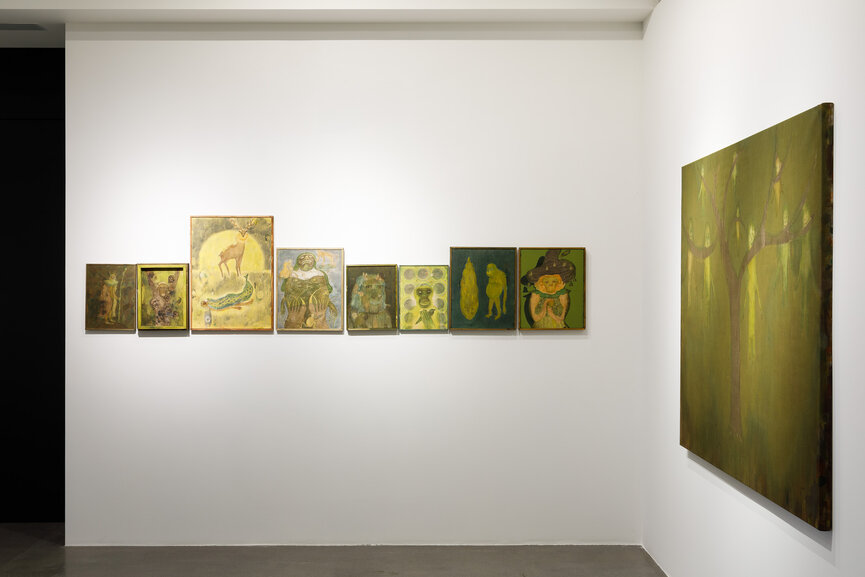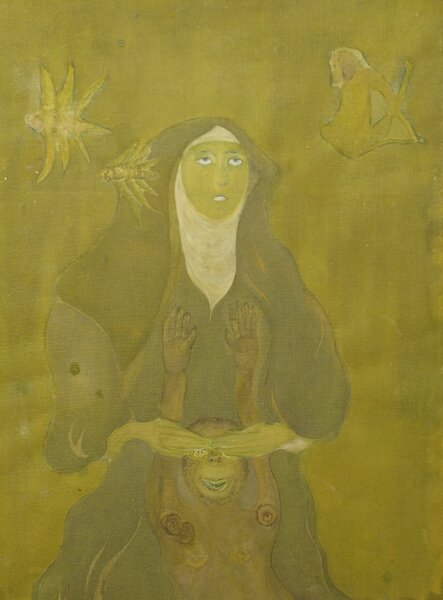BEGALSKA VIKA AND / VILKIN ALEXANDER.
DOG'S SPOON
27.04 - 27.06.2022
The main space - Marina Gisich GALLERY
Mon - Sat
11 - 19:00.
Registration is not needed
Free entrance.
QR-code and Wearing mecical mask is required
FOLLOW US on Instagram:
Gallery

Vika Begalska (b.1975, Dnepropetrovsk, Ukraine) and Alexander Vilkin (b.1982, Snezhinsk, Chelyabinsk region) are working as an artistic duo since 2014. Both authors were already well-known and recognizable artists, each having his personal background and artistic method when they started working together.
Vika Begalska studied at the Kharkov Academy of Design and Arts. She lives in Moscow since 2001. The feminist projects made her famous. In 2013 she became a co-founder of the artistic platform “The Feminist Kitchen”. Along with the painting as the main media she works with video and performance.
Alexander Vilkin graduated from Chelyabinsk Art College, also he studied at Northwestern Institute of Printing Arts (St. Petersburg) and at “BAZA” Institute of Contemporary Art (Moscow). In 2006 he co-founded the art group “Prosthesis” together with Igor Mezheritsky and Grigory Yushchenko in St. Petersburg. Since 2006 he is also a member of the artistic group Parazit. Since 2014 he lives and works in Moscow.
One of the brightest projects by Begalska and Vilkin – the puppet show Aphrodite's Girdle (as the members of the Teresa Creative Union) which was awarded the State Prize for Contemporary art “Innovation”, nominated as “The work of visual arts”. In 2017 the show was played and became a part of the M HKA collection (Antwerp).

In 2020, thanks to a gift from the Vladimir Smirnov and Konstantin Sorokin Foundation the works of the artists were included in the collection of the State Tretyakov Gallery, the catalog of the collection is available in the section Shop Now.
The artists are creating their own poetic world. And we can see that in this world they are equalizing very different characters, even the inanimate ones. The knight-insect, the flower, just painting texture that suddenly is blowing up or the the strangely dressed character is coexisting with the abstract painting. We are contemplating the total mix of everything, de-anthropomorphizing, denial of all that might be antropocentric; everything is being so equaled that sometimes the characters are falling through the painting. The poetic component makes this combining of incompatible possible.
In fact, this is a simple exhibition with a number of repeating symbols, situations united by a common mood and aspiration. Three recurring motifs that duplicate each other constitute an incomplete but solid framework for a general reading.
1. Circle/Eclipse/Lighthouse. The circle is present both in ornamental inserts and on its own. The circle is a closed, ideal shape that has limitation. But at the same time, the circular motion that forms space is potentially infinite. A circle is both a cycle and a large point at the same time.
The circle is what an exorcist draws around himself during the ritual protect himself from an attack by a black, hostile, diabolical force. A circle can become an image of a planet, a tambourine in the hand or a bright spot on the floor like in the game of twister, used to search for the place of the body in space. Sometimes the circle becomes a black sun, an eclipse, and sometimes a trace of an extinguished lighthouse. If there is a lighthouse, even if it no longer provides light, then it hides and confuses bearings in the darkness, but if there is a lighthouse, then there must be a lighthouse keeper.
Alexander Vilkin, Vika Begalska
2. Human with monkey/Figure with monkey/lighthouse keeper/. The lighthouse has gone out, and it no longer matters whether this was caused by human or non-human factors. The lighthouse still went out, the trace of the lighthouse became a black funnel, and the lighthouse keeper became a homeless person, a pilgrim, a wanderer. He may be a walking figure or a standing figure, but he is a figure without a map, who has become nullified, who finds himself in a new situation that he does not yet fully understand. He has lost a great deal, but he still has a monkey – the primary initial hypostasis, which can serve as the beginning of all beginnings, and a new chance (in Renaissance mysteries, the monkey represents the pre-human state, before it gained a soul). Soon the renewal will be complete: the monkey will stand up on its hind legs, plunge into the salt water and walk forwards.
Alexander Vilkin, Vika Begalska
3. Mouth/orifice. The mouth absorbs and expels. Expulsion as an act of purification. Keeping the mouth open with a spoon in an epileptic fit, to stop the patient biting their tongue with clenched teeth, and avoid losing their voice – only in this way, through preserving the voice and speech, is it possible to attempt to be reborn again. The mouth expels arrows, flowers and snakes. Sometimes the spasmodic mouth itself remains open in a silent scream, sometimes the skeleton obligingly keeps its jaws open, but in any case an act of rejection is necessary for an act of renewal.
Alexander Vilkin, Vika Begalska
The exhibition “Dog’s Spoon” by Vika Begalska and Alexander Vilkin is an artistic contemplation of inhuman dimensions – sizes, languages, situations and signals.
The name of the project sounds bizarre at first – what’s a “dog’s spoon”? It seems to be utterly meaningless, since dogs don’t eat with spoons, unlike people (and only people). But when we look at Begalska’s and Vilkin’s art, we also encounter people there – they are certainly strange, but they are still people.
Then what’s the catch? Probably because although the artists depict people, the artworks are not really about people – or rather they are about situations when people become participants. Besides human characters, these situations feature with dancing skeletons, playful nuns, monkeys, dogs and donkeys. Often the characters are not immediately discernible – the dull colors and the gentle, barely noticeable contrasts immerse us in the pictures which eventually talk to us and tell us their stories. Begalska and Vilkin play with images, at the same time flirting with the viewers, allowing us to guess what the pictures are in fact saying to us in their own artistic language.
Natalya Serkova
The phenomenon of language, or tongues, plays an important part in our discussion.
A spoon, a simple, familiar piece of cutlery, comes into contact with the tongue, or rather with tongues.
The first tongue of contact with the spoon is the eating tongue that senses taste, a greedy, healthy tongue. While it is eating, it makes no noises, it is mute, absorbed in the process.
The other tongue is also mute, but for a different reason. This is the tongue of illness, epilepsy, convulsion – it is saved by a spoon that is placed between the jaws of a person having a fit.
The third tongue is the tongue of the medical checkup, when the spoon is put down a person’s throat, while the throat makes the awkward “aaaaa” sound.
All three tongues exist in three different dimensions and are connected by this simple cold metal object. The spoon becomes the conductor between tongues, but tongues which do not produce articulate speech, tongues of mute but still human life.
Natalya Serkova
Inhuman life emerges somewhat later, somewhere nearby, on the periphery of our vision. It is also mute and capable only of producing inarticulate sounds, barking, bleating or squealing. Humans start to share their muteness with animals – and the spoon, this cause of human muteness, becomes a symbol of animal muteness. Animals, and skeletons along with them, these obvious images of death, sing and dance, opening their mouths at each other (as if playing at epilepsy, this human disease), entertain nuns, and entertain themselves. As if on the other side of the canvas, music plays, setting the tempo for the characters, although we do not hear it. Perhaps for it to be heard, we need to look for the missing link – the spoon that will keep our jaws apart and create this miracle of metanoia, an onset of mindlessness that brings together people and animals, dance and stupefaction, the tongue and the howl, death and unbridled joy.
The mouths of the characters — painted mouths, inhuman mouths, animal mouths — are busy devouring, with a song or a spoon, measuring inhuman time inside the event of an inhuman game.
Natalya Serkova
So what is actually happening in these artistic pastorals? Nuns possessed by devils go towards the light of fading lighthouses, skeletons mock donkeys, and the monkey tries to become a human being, but fails (perhaps because its time is up). We seem to be witnesses of dozens of micro-events, events which took place in a dimension where music is heard. At the same time, perhaps, our characters have not managed to understand this yet – to understand that the event has already taken place, that the light in the lighthouse has gone out, that the nun is only saved by lust combined with true faith, and that the monkey will never become a human being. The characters remain mute, like art itself – mute and lost, despite their feigned merriment. They are lost like the model romantic hero who was lost in his own time, but always found an escape – usually in his own death.
We cannot know what escape these characters will find (and whether they will find one at all) – but we can keep the heads of some of them up, while the tender-hearted skeleton dances and opens their inhuman jaws one by one with his dog’s spoon.
Natalya Serkova
“The oversaturated and thick fabric of the paintings, the onrush of images, and their languid sensual nature reference the aesthetics of Peter Greenaway, who loves to engage a rich selection of visual associations that draw up lines and quotations from diverse works of art all in a single scene. The artists play with citations as well, composing a whimsical game of solitaire out of imagery, narratives, and motifs. The lush attire donned by these paintings is intended to entice the viewer to join in a guessing game, to become an unwitting voyeur, only dimly aware of what is happening before his eyes. This unexpected move seems risky for the artists, who remain loyal to their chosen narratives, motifs and themes”.
Gleb Yershov













































